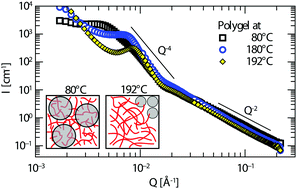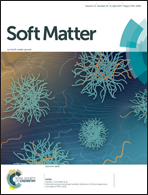Internal structure and phase transition behavior of stimuli-responsive microgels in PEG melts†
Abstract
In this work we investigated the behaviour of stimuli-responsive poly(N-vinylcaprolactam) (PVCL) microgels in poly(ethylene glycol) (PEGs) with a linear architecture. We performed small-angle neutron scattering (SANS) experiments at two different microgel concentrations and various temperatures. The results were compared with those on PVCL microgels in water. PVCL in PEG (molecular weight MW = 2 kg mol−1) exhibits a volume phase transition temperature (VPTT) at a temperature between 160 and 180 °C. The diameter of the swollen microgel is only slightly smaller than in water. Furthermore, with increasing molecular weight of the surrounding polymer matrices fewer chains penetrate the microgel particles. In agreement with that, we identify a decreasing diameter with increasing molecular weight. In the short chain polymers up to MW = 3 kg mol−1, PVCL is well dispersed in the matrices with only minor signatures of agglomeration. For the well dispersed systems, we find unperturbed chain conformation of the PEG. Our results clearly show that the miscibility of PVCL and PEG disappears in a molecular weight range of 3 to 10 kg mol−1.



 Please wait while we load your content...
Please wait while we load your content...